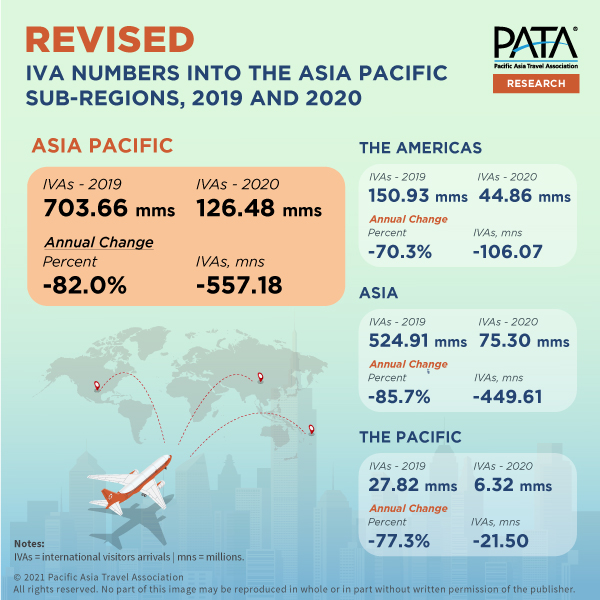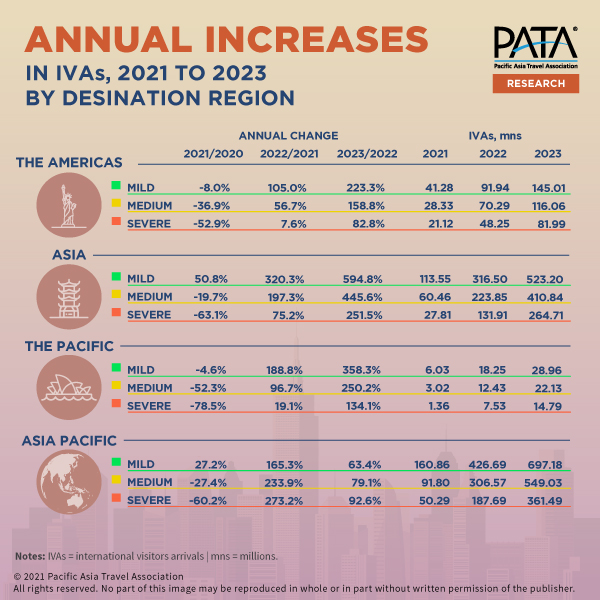BANGKOK, 7 June 2021: Asia Pacific’s travel industry faces a hard year ahead the second in a row caused by persistent and repeated waves of the Covid-19 pandemic, but a light glimmers indicating recovery awaits us during 2022.
That’s the bottom line conclusion of the new mid-year revision of the ‘Asia Pacific Visitor Forecasts 2021-2023′ from the Pacific Asia Travel Association (PATA).

PATA, in its preamble to the revised reports, admits that the Covid-19 pandemic necessitates constant reviews with future predictions being continuously revised.
PATA Asia Pacific Visitor Forecasts 2021-2023 projections were made using estimated baseline data for 2020, from each of 39 destinations within the Asia Pacific. Most of the earlier forecasts became irrelevant as new data emerged.
Now PATA’s latest evaluation suggests the contraction rates and loss of arrivals remain severe, with an overall reduction between 2019 and 2020 of more than 577 million foreign arrivals. The losses are now forecast to continue throughout 2021 for most sub-regions under all scenarios.
PATA claims there is still good news to found in the latest forecast that suggests the 2022 outlook could be more promising, with annual increases across the board, ranging from gains of 105% to 320% under the mild scenario, to between 8% and 75% even under the severe scenario.
But the association warns that it is important not to be seduced by such large annual percentage increases. Despite the forecasted gains, the absolute volume of arrivals remains well below the 2019 benchmark for international visitor arrivals, even out to 2023 under some scenarios.
The expected results for 2021 average just 23% of the 2019 volume at best. In 2022 that is expected to increase to between 27% and 61% depending on the scenario, reaching between 51% and 99% by 2023, again, depending on the prevailing scenario at that time.
If there is to be any recovery in 2021, it is expected to come from mostly Northeast Asia source markets, with the Russian Federation having the potential to boost in numbers. Collectively, this top five source market cluster is expected to add an additional 29 million IVAs into Asia between 2020 and 2021, representing some 80% of the predicted increase into the region over that period.
Commenting on the outcome, PATA CEO Liz Ortiguera
explains: “Expectations for a return to the past should be shelved and more attention paid to those source and destination markets best preparing to drive recovery within the Asia Pacific. Travel recovery is being driven by a complex range of factors from the varying market policies regarding virus control and containment to local citizens’ sentiments on vaccine take-up.”
Ortiguera continues: “Success will come to those that efficiently implement science-based best practices to control the pandemic in their home markets to restore both source market government and consumer confidence. In the travel industry, a “duty of care”-based approach in delivering services and products will support a more sustainable recovery.”
She concludes with the advice, “On a positive note, our forecast projects a pent-up demand for travel experiences in the Asia Pacific region. Flexibility in marketing and delivering new experiences to engage travellers as corridors open up will be critical.”
The updated PATA Asia Pacific Visitor Forecasts 2021-2023 is now available at https://www.pata.org/research-q1v63g6n2dw/p/asia-pacific-visitor-forecasts-2021-2023-updates.










